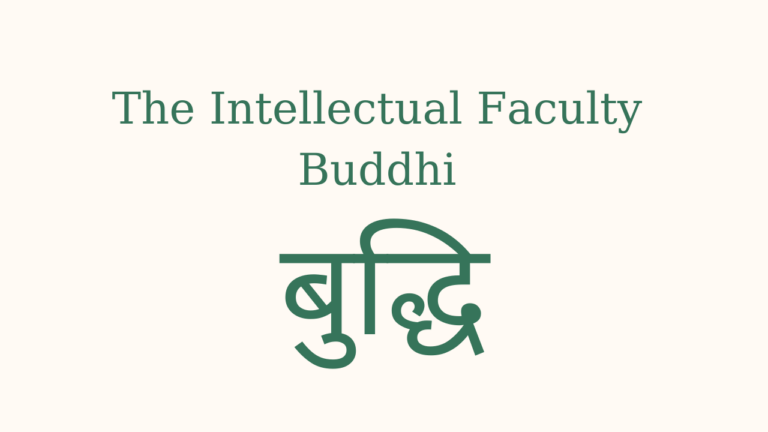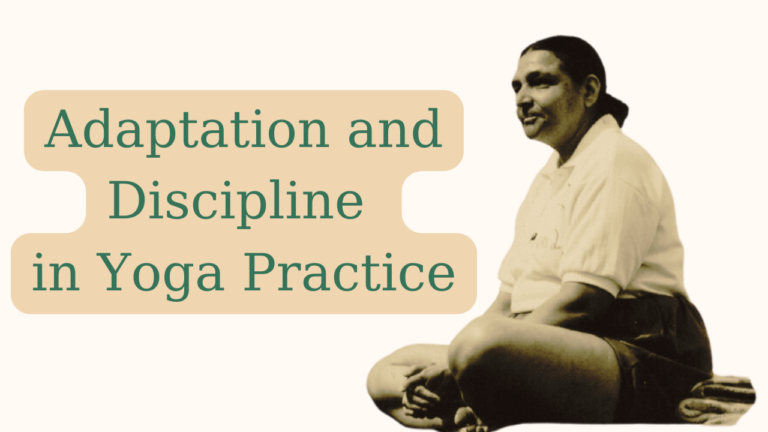
Understanding Buddhi: The Intelligence in Yoga Philosophy and Practice
According to Geeta S. Iyengar’s “Yoga – A Gem for Women,” buddhi
Reading Unit 3 includes VIII Know Your Body, IX Yoga Sadhana, X Hints and Suggestions, XI Classification, Table and Course of Study.
Geeta Iyengar presents ethical discipline and physical practice as inseparable in yoga. She describes yamas and niyamas as natural developments through practice rather than rigid rules. Her framework categorizes practice intensity into three levels (mild, middling, intense), emphasizing that progress depends on inner strength and multi-level awareness while cautioning against ego attachment.
Her practical guidelines accommodate women’s daily responsibilities, with flexible recommendations for practice timing, environment, and diet. The chapter introduces a comprehensive three-year progressive course (elementary, intermediate, advanced) based on anatomical structure, spinal movement, and mind-body effects. While providing structured schedules, Geeta emphasizes that actual progress depends on individual dedication, demonstrating her deep understanding of both pedagogical principles and the body’s need for gradual development.
In this part, Geeta establishes the foundational understanding that ethical discipline and physical practice are inseparable in yoga, comparing them to parallel tracks of a railway – both essential for the journey. The yamas (ethical restraints) and niyamas (observances) are presented not as rigid rules but as natural developments that emerge through dedicated practice. While Geeta acknowledges that while perfect adherence to these principles might seem impossible for women managing family life, she emphesizes that gradual progress naturally cultivates appreciation for ethical disciplines.
Here Geeta presents a sophisticated framework for practice intensity through three levels – mṛdu (mild), madhya (middling), and adhimātra (intense) – with each category further subdivided to accommodate individual differences. This approach emphasizes that progress depends not on external factors but on inner strength and endurance. The role of buddhi (intelligence) in practice is extensively explored, explaining that āsana movements are not mere physical actions but have physiological and psychological dimensions requiring awareness at multiple levels. The text warns against the trap of ahaṃkāra (ego) that can arise with progress.
Geeta’s practical guidelines are comprehensive and adaptable to women’s daily lives. While early morning (brāhma-muhūrta) is presented as the ideal practice time, the text provides alternatives for beginners and those with family responsibilities. Environmental considerations include proper ventilation, appropriate clothing, and the importance of a clean, dedicated practice space. Dietary recommendations are particularly detailed, addressing not just what to eat but when to eat in relation to practice, with specific guidance for different body types and conditions.
A sophisticated classification system for āsanas is based on three criteria: anatomical structure, range of spinal movement, and effects on body and mind. This leads to a systematic three-year course of study. In the first year (prārambhika/elementary) one should establishe one’s foundational practices. In the second year (madhyama/intermediate) one should build on basics with more complex poses, and then in the third year (pariṇata/advanced) , one is introduces to sophisticated variations. Each level includes detailed weekly practice schedules, with the text emphasizing that while the course is structured for three years, actual progress depends on individual dedication and capacity. Geeta’s overall approach reflects a deep understanding of both pedagogical principles and the body’s need for gradual, consistent development in yoga practice.
Why does Geeta emphasize yama and niyama as prerequisites for practice? What are the challenges of maintaining ethical discipline in daily life?
What is the significance of the three levels of engagement (mild, middling, and intense) in practice? How does this framework accommodate individual differences?
How does the twelve-section classification system for asanas reflect a deeper understanding of the body’s needs and development?
What role does intelligence (buddhi) play in practice, according to the text? How does this differ from mere physical exercise?
In our latest Yoga Readers session, we delved into Unit Three of Geeta Iyengar’s landmark text, “Yoga: A Gem for Women.” This pivotal section bridges the theoretical aspects of yoga with practical application, offering invaluable guidance for practitioners at all levels.
Geeta Iyengar’s approach is unique in how she weaves together traditional Sankhya philosophy with modern anatomical understanding. Rather than presenting these as separate domains, she demonstrates how they complement each other, creating a holistic framework that honors both ancient wisdom and contemporary knowledge. This section serves as the perfect transition point in her book, preparing readers to move from philosophical groundwork to embodied practice.
At the heart of our discussion was Geeta’s detailed exposition on sadhana (spiritual practice). She emphasizes that yoga is not a hobby or entertainment but a serious discipline requiring “faith, enthusiasm, determination, keenness, courage, will and dedication.” Yet within this disciplined approach, she maintains profound compassion for the practitioner’s journey.
Geeta outlines three types of practitioners—mild, middling, and intense—with further subcategories that acknowledge the spectrum of human capacity and inclination. This nuanced categorization reminds us that yoga practice must be tailored to individual needs rather than forcing everyone into the same mold.
One of the most practical aspects of our reading was Geeta’s guidance on dealing with pain and discomfort in practice. She offers a sophisticated framework for distinguishing between “healthy” and “unhealthy” pain:
This framework provides practitioners with essential tools for self-assessment, encouraging mindfulness without promoting either avoidance or pushing through harmful sensations.
A significant theme that emerged in our discussion was the ongoing dialogue between discipline and adaptation. Geeta advises practitioners to be patient with their progress, to observe differences between the right and left sides of the body, and to use the more proficient side as a guide for the less efficient side.
As Dr. Wittich noted, this represents a balanced approach that avoids both excessive rigidity and excessive leniency. The practitioner is encouraged to maintain consistency while being sensitive to their body’s needs and limitations.
Women’s Practice Through Life Changes
Perhaps most revolutionary was Geeta’s detailed guidance for women’s practice during different life stages. In an era when yoga was still largely considered a male domain, Geeta provided comprehensive recommendations for:
This women-centered approach was groundbreaking, acknowledging women’s unique bodily experiences and demonstrating how yoga could support rather than hinder feminine wellbeing.
The Three Stages of Learning
Geeta articulates three fundamental stages in the learning process, drawing parallels between traditional learning methods and yoga practice:
This framework highlights that yoga is not merely physical exercise but a comprehensive path of transformation that engages body, mind, and spirit.
The session concluded with an examination of Geeta’s structured approach to practice progression. She outlines a three-year course of study divided into elementary, intermediate, and advanced levels, each building systematically on the previous. While this structured approach might seem demanding by today’s standards, it reflects the Iyengar tradition’s emphasis on precision, proper sequencing, and gradual development.
Our reading revealed Geeta Iyengar’s profound understanding of yoga as a lifelong journey requiring both discipline and sensitivity. Her approach honors the challenges practitioners face while providing practical tools to overcome them. Most importantly, she demonstrates how yoga can be adapted to meet women’s changing needs throughout different life stages, making it a consistent source of support and transformation.

According to Geeta S. Iyengar’s “Yoga – A Gem for Women,” buddhi

Understanding discipline and adaptation in yoga practice is crucial for any practitioner.
“Writing, Practice, and the Evolution of Iyengar Yoga for Women” This session…
What a joy it was to connect with so many of you…
Reading Unit 1 includes the Forwards, Preface, I First Steps in Yoga,…
Reading Unit 2 includes IV Are Women Eligible for Yoga?, V The…
A Special Session with N. Sine Ozsoy This talk will provide a…
Reading Unit 3 includes VIII Know Your Body, IX Yoga Sadhana, X…
Reading Unit 4 includes I: Standing asana, II: Forward Bends Chapter Summary…
A special exploration for the Yoga Readers community Join a unique session…
Reading Unit 5 includes III Sitting and Supine Asana, IV Inverted Asanas,…
Reading Unit 6 includes VI Asanas: Twists, VII Asanas: Backbends, VIII Asanas:…
Reading Unit 7 includes IX Pregnancy Asanas and Pranayama & X Advanced…
Unit 8 includes XIII On the Threshold of Peace, XIV Hints and…